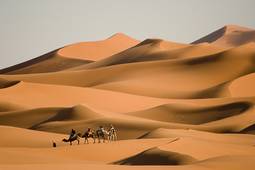Plan an amazing trip to Algeria
A land of extremely diverse terrain, Algeria is bordered to the north by the Atlas Mountains, which meet the Mediterranean Sea, and the Sahara, the vast desert to the south, which occupies a large part of the country. The most important towns are found on the coastal plain, facing the sea, and benefitting from the Mediterranean climate.
Since antiquity, this country has been heir to an exceptional cultural and architectural heritage. Before the arrival of Muslims, the area was occupied by Phoenicians, Carthaginians, and Romans, creating a destination rich in well preserved Roman archaeological sites, such as Djemila and the ancient city of Timgad, now a UNESCO world heritage site.
The capital, Algiers, is definitely worth visiting, with its casbah clinging to the hillside, the historic district (also a UNESCO world heritage site), whitewashed houses and ancient mosques which can be reached through the steep and winding backstreets. Facing the sea, the modern district recalls its colonial past with its white hued walls.
Oran, further to the west is known for its Ottoman fort, built by the Spanish, whereas landlocked Constantine is captivatingly beautiful, with its bridges suspended above impressive ravines, and has a rich heritage.
Algeria is also the Kalâa des Béni Hammad, the 9th century archaeological site 1,000 metres above sea level, the fortified villages of the M’Zab Valley in the middle of the desert, and the numerous national parks which are home to numerous species of protected plants and animals.
The adventurous can admire the spectacular Mountains in the middle of the Sahara, before stopping in Tamanrasset for an out of this world experience.
Best time to go to Algeria
Check our complete climate guide to know the ideal season for your next trip. Month by month, you will find the temperatures, sunshine and rainfall history.

















